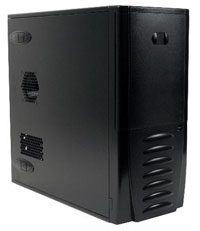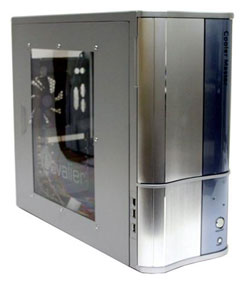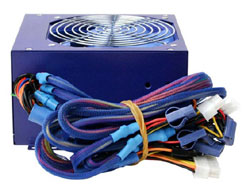Buyer's Guide - Mid-Range, January 2005
by Jarred Walton on January 21, 2005 11:09 AM EST- Posted in
- Guides
Case and Power Recommendations
We've got all the internal components picked out now, so all that's left is the choice of case, monitor, and a few other external parts. Preference for case design can vary wildly from person to person, so if you have a favorite case, you should get that. A lot of us prefer the clean, elegant looking cases as opposed to models that have a lot of bling-bling, so that's what we'll recommend. Besides, those who really like the bling are better off modding their cases for a truly unique look. We also like quiet cases where possible, although silence and high performance are nearly impossible to achieve at the same time. Finally, for most mid-range and above configurations, you really need a decent power supply to ensure maximum stability - and for that matter, a battery backup is also a good idea. You could try to get a case with a decent power supply included - the Antec cases that we frequently recommend are sufficient for the basic setup - but that really limits your choice of case. We prefer to look at all options and just plan on adding a better power supply - and if you're seriously considering the SLI configuration, don't even think about getting by with a cheap PSU!
Case Recommendation
Antec SLK-3000-BPrice: $76 Shipped
If that case looks familiar, we're not surprised. We've recommended the 3700-BQE as well as several other BQE Antec models in many of our recent Guides. They include decent power supplies and have a reasonable price, all things considered. The 3000-B is a newer addition that builds off the 3700, only without a power supply. This is a great starter case, and it is very easy to set up initially as well as upgrade over time.
There are a few minor differences between this model and the 3700. First, it includes a cooling duct that allows the CPU fan to draw in cool air directly from outside. There are ventilation holes on the left side of the case for both the duct as well as lower down over the expansion card area. The case includes a 120 mm temperature controlled fan in the rear - a fan that is very close to silent - and there is room to add another 120 mm fan in front of the hard drive bays. Rather than slots for four hard drives with a tray, there are five hard drive slots. We're not sure if we like the loss of the trays, as they do make it easier to temporarily remove the drives. Overall, though, we like the modifications, even if they're not terribly important in the larger scheme of things. About the only missing feature that some people will want is a front Firewire port.
If you go with the base mid-range configuration that we're recommending in this Guide, you could probably go with the 3700 and get the included 350W PSU for about $20 more, but we recommend the purchase of a more capable power supply. The Antec Sonata is also available for a few dollars more and includes an even better 380W "TruePower" power supply, but it isn't quite as roomy, should you add the second 120 mm fan. For the overclocking/enthusiast configurations, you'll definitely need a better power supply - especially if you actually plan to go for an SLI system during the life of the computer. Our PSU recommendation is below.
Case Alternative
CoolerMaster Cooler Master Cavalier 3, model CAV-T03-WWPrice: $112 Shipped
If you want a case that's a little flashier, we like the CoolerMaster Cavalier. It's available in a couple of different color schemes, with the silver/blue model shown here. It has a case window; front USB, audio, and firewire ports; a rear 120 mm fan; and a steel frame with aluminum front bezel and panels. Expansion options include five 5.25" external bays and four 3.5" bays, one of which is external. All of the bays have a tool-less latching mechanism that works pretty well. The external drive bays are all covered by a door, but there's a catch with this design: the direction that the door opens can be modified. Most doors open to the right, but that doesn't always work for some people, so it's nice to see a case that addresses that concern. Overall, this is a very well constructed case at a reasonable price.
Power Supply Recommendation
Fortron Source Blue Storm 400W, Model FSP400-60THN-RPrice: $59 Shipped
Our choice of power supply comes from Fotron Source, one of the more reliable manufacturers. It has several noteworthy features that put it ahead of competitors. The 120 mm fan helps to reduce the noise levels relative to most 80 mm fans, and it has sheathed cables. Another nice addition is the inclusion of a 24-pin BTX/EPS12V power connector, with a 20-pin ATX power adapter. It's certainly not required for all motherboards, but for the latest Intel models, we prefer to go with a 24-pin connector instead of a 20-pin. It also includes dual 12V rails, which helps to guarantee a sufficient amount of power to components such as hard drives and graphics cards. While 400W may not seem like all that much, we consider this a quality 400W PSU - many lesser brands would rate this as a 500W+ PSU.
Good alternatives from Antec, Enermax, OCZ, Sparkle, Ultra and several others exist, but they all tend to cost a bit more than the Fotron Source PSUs. We've recommended several of these power supplies in past Guides, and the previous recommendations still stand. One item that is missing from this Fotron is the new 6-pin PCIe graphics power connector - two 4-pin molex connectors can be used with an adapter, of course. Some may also find the blue light within the PSU to be a bit distracting, although it's really not so bright that would cause us to worry about it. As an alternative, check out the OCZ ModStream and PowerStream PSUs; they cost a lot, but their warranty and reliability is very good. A more powerful PSU would definitely be recommended for SLI setups.













46 Comments
View All Comments
JarredWalton - Friday, January 21, 2005 - link
Rand - That doesn't surprise me too much, given our recent article showing that the NF4 Ultra and NF4 SLI are the same chip with a tweaked package. I would guess there's a reasonable chance the NF4 4X is the same as well, with other modifications to the package. As far as I know, what I put about their difference is the "official" NVIDIA stance. If the 4X is just the "validated" version... well, not a big deal, really. I'll modify the text a bit to reflect this.KristopherKubicki - Friday, January 21, 2005 - link
N3cr0: The nForce4 board you mentioned is not shipping yet.Kristopher
Jep4444 - Friday, January 21, 2005 - link
I think the Asus A8V Deluxe would of been a better motherboard recomendation than the MSI K8N Neo2 Platinum. The Asus board is pretty much the best 939 AGP board out and it costs less than the MSI aswell.Avalon - Friday, January 21, 2005 - link
'Samsung calls the 997DF a "perfectly visually flat" tube. What they really mean is that the surface of the glass is perfectly flat, but the inside of the glass is very slightly curved. Most people will never notice it, but we feel that in the interest of full disclosure, it should be mentioned'Yes. Thank you for pointing that out, Jared. I purchased this monitor about a month ago, and noticed it right upon powering it up. No matter how much you adjust the geometry, there is always a slight curve. I was so angry at one point I was either going to hit it with a bat or return it. Now I've just learned to deal with it, and I'm no longer really bothered by it.
Rand - Friday, January 21, 2005 - link
Slight addendum to my above post-I just tried nVidia's hardware firewall.. it's working fine.Apparently that also runs on the basic nForce4.
Rand - Friday, January 21, 2005 - link
Slight addendum to my above post-I just tried nVidia's hardware firewall.. it's working fine.Apparently that also runs on the basic nForce4.
Rand - Friday, January 21, 2005 - link
"The difference, if you recall, is that the Ultra has an unlocked HyperTransport multiplier and will generally offer more in the way of overclocking, while the 4X is locked at a 4X HyperTransport multiplier (800 MHz)."I believe that's since been proven false.
There are a couple threads in the Motherboards forum about overclocking on said board, and I haven't seen anyone comment on any difficulties adjusting the HTT.
My own board is running at 300x3 HTT (900MHz HTT) right now. (Adjustable from 2-5X), though it did need +0.2V to the chipset to run stable at 1000HTT.
The differences right now between the NF4 and NF4 Ultra would appear to be 3Gb/s SATA vs. 1.5Gb/s SATA, and official support for 1000HTT vs 800HTT.
As well as not supporting nVidia's firewall.
geogecko - Friday, January 21, 2005 - link
Where are all the nForce4 Ultra (non-SLI) boards? Really looking forward to ASUS A8N-E Premium, but no news, except that some have said this board will never exist?!Gage8 - Friday, January 21, 2005 - link
I don't know, this guide just confirmed for me that now is not the time to buy if you want stability and upgradability (new word?).Nforce2 taught me not to buy revision 1.x...so lesson learned, bring on Nforce4 revision 2.x.
N3cr0 - Friday, January 21, 2005 - link
Just curious why the MSI K8N Neo4 Platinum/SLI wasn't put in as an SLI board for the AMD choices. It seems to be lower price then the Asus board. I'm going to get one of the two boards and can't really figure out what the differences are aside from some networking items. (That and the HyperTransport which I dont get at all)